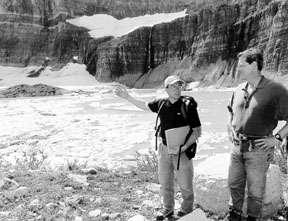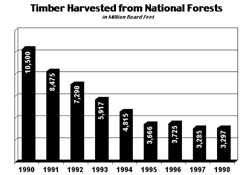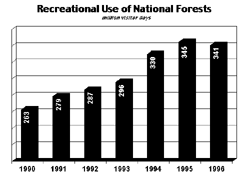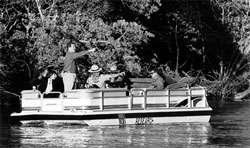|
| |
| |
President Bill Clinton At the beginning of the 20th century, President Theodore Roosevelt dedicated our Nation to "the great central task of leaving this land even a better land for our descendants than it is for us." At the dawn of a new century, President Clinton and Vice President Gore are fulfilling this vision, and ensuring that future generations of Americans have the resources to carry on this legacy in the years ahead. Under their leadership, the Administration has strengthened protection for millions of acres of federal lands; saved and restored natural treasures from Florida's Everglades to California's ancient redwoods; helped hundreds of communities across the country protect parks, farms, and other local green spaces; and forged partnerships with landowners to restore and preserve the natural values of America's private lands. With new initiatives now underway, including the President's plan to protect roadless areas within our national forests, the Administration is on track to protecting more land in the continental United States than any Administration since the time of Teddy Roosevelt. Creating Monuments for All Time One of the tools that can be used to preserve America's natural heritage is the Antiquities Act, which authorizes the President to create national monuments on federal land to protect "objects of historic and scientific interest." The Act was first used by President Theodore Roosevelt, who created the Grand Canyon National Monument — the core of what later became Grand Canyon National Park. President Clinton has employed the Antiquities Act to protect more land in the lower 48 states than any President in history, creating or expanding five national monuments:
Defending the World's First National Park  Photo: Glacier National Park, September 1997 Yellowstone National Park, created in 1872, is known around the world for its spectacular wildlife and geysers. But a massive gold mine proposed not far from the park threatened Yellowstone with toxic runoff and other environmental harm. In 1996, President Clinton announced a $65 million agreement with Crown Butte Mines that halted the proposed New World Mine, ending the threat to Yellowstone. Last year, the President announced another major step to protect the greater Yellowstone ecosystem: acquisition of the 9,300-acre Royal Teton Ranch adjoining Yellowstone. Protection of these lands preserves critical winter range for the park's bison and protects underground geothermal resources that feed the park's world-famous geysers. Restoring Balance to Our National Forests
 Source: U.S. Forest Service  Source: U.S. Forest Service Annual Report
In a major step to preserve some of America's last wild lands, President Clinton directed the Forest Service in October, 1999 to develop a rule to protect more than 40 million acres of pristine "roadless" areas within the national forests. Final action is expected in late 2000. In addition, the Forest Service has proposed:
Saving California's Ancient Redwoods When a family-owned timber company in Northern California was taken over, and the new owners accelerated the logging, the world's largest unprotected stand of old-growth redwoods was suddenly threatened. The Clinton-Gore Administration forged an agreement, and secured $250 million in federal funds, to preserve the 7,500-acre Headwaters Forest — saving trees up to 2,000 years old and critical habitat for threatened and endangered species. The agreement also provided for a comprehensive plan to protect wildlife habitat and ensure sustainable logging on the company's surrounding timberlands. Restoring the Florida Everglades In 1996, Vice President Gore launched a long-term strategy to restore an extraordinary but endangered natural treasure — the Florida Everglades. In close partnership with the state of Florida and other stakeholders, the Administration has worked to acquire and protect critical lands, improve water quality,  Photo: Florida Everglades, December, 1997 restore endangered species, accelerate scientific research, and increase fresh water flows to Everglades National Park. The effort represents the most ambitious environmental restoration project ever attempted. Last year, the Administration and the state of Florida proposed a major undertaking critical to the project's success — a $7.8 billion plan to rebuild the region's water system to more closely mimic nature's design. The plan would nearly double the amount of fresh water available in South Florida, ensuring clean, plentiful flows for the Everglades and adequate supplies for cities and farms. Restoring the San Francisco Bay-Delta In 1995, the Administration reached a landmark agreement with the state of California that is laying the groundwork for a lasting solution to the state's perennial water conflicts. Under the CALFED agreement, the federal and state governments are undertaking interim measures to restore San Francisco Bay and the adjoining Sacramento-San Joaquin River Delta, while ensuring adequate water supplies for cities and farmers. Since 1997, the Administration has secured $190 million in federal funds for environmental restoration through the Bay-Delta program. CALFED's proposal for a long-term plan to balance environmental, urban, and agricultural needs is due later this year. Protecting and Restoring Our National Parks America's national parks are drawing record numbers of visitors, and the Administration is undertaking new initiatives to ensure that future generations can continue to enjoy them in all their splendor. On Earth Day 1999, Vice President Gore announced a long-term strategy to restore pristine skies and unspoiled views to national parks and wilderness areas by reducing pollution from power plants, cars, and factories hundreds, even thousands of miles away. In several major parks, new transportation plans emphasizing the use of public transit and clean fuels are helping to reduce congestion and pollution. A clean-fueled shuttle bus system at Acadia National Park carried over 140,000 passengers in its first summer of operation, and similar shuttles will soon be introduced at Zion National Park. In Yosemite Valley, a new master plan will ease crowding and restore developed areas to natural conditions. At the Grand Canyon, new rules for sight-seeing flights will help restore the natural quiet, and a planned light rail system will ease congestion. Throughout the park system, entrance and recreation fees are now being reinvested directly in the parks to help meet critical maintenance needs and put our national parks on firmer financial footing. Protecting the California Desert The California Desert Protection Act, signed by President Clinton in 1994, provided new or enhanced protection for 6.6 million acres of spectacular landscapes in the Mojave and Colorado Deserts of Southern California. The new law created the 1.4 million-acre Mojave National Preserve; expanded Death Valley and Joshua Tree National Monuments, and redesignated them as national parks; and provided wilderness protection for 3.6 million acres of Bureau of Land Management lands. Stemming the Loss of Precious Wetlands Wetlands play a vital role in sustaining wildlife, filtering pollutants from our water, and protecting communities from flooding. Yet more than half the historic wetlands in the continental United States have been lost. To help reverse this loss, the Administration has undertaken major reforms of wetlands regulation. New "nationwide permits" adopted this year by the Army Corps of Engineers require rigorous review of any project affecting more than half an acre of wetlands. Apart from protecting wetlands, the new permits will substantially decrease development within floodplains, preventing serious threats to life and property. In addition, the President's Clean Water Action Plan sets a nationwide goal of a net increase of 100,000 acres of wetlands a year beginning in 2005.
Forging Conservation Partnerships with Farmers Most of the land in the United States is in private hands, and the nation's economic and environmental well-being rests in part on keeping these lands healthy. Through a range of initiatives, the Administration has forged innovative partnerships with farmers and other landowners to encourage voluntary conservation efforts and strengthen rural economies. The Wetlands Reserve Program provides technical and financial assistance to property owners who enter into permanent or long-term agreements to restore and maintain wetlands. The Conservation Reserve Program provides annual payments to farmers who remove environmentally sensitive lands from production and improve them by restoring wildlife habitat, planting windbreaks, or creating streamside buffers. The Administration's Conservation Reserve Enhancement Program greatly expanded these efforts by encouraging states to commit matching funds targeted to urgent conservation needs, such as restoring Chesapeake Bay and Pacific Northwest salmon. Agreements have been signed with Delaware, Illinois, Maryland, Minnesota, New York, North Carolina, Oregon, Pennsylvania, Virginia, and Washington, and others are in the works. Through these programs, the Administration has helped stabilize farm income while securing conservation improvements on more than 32 million acres of private land nationwide. The President's budget for the coming year proposes a $1.3 billion Farm Conservation Initiative to significantly expand conservation partnerships with farmers, ranchers and other landowners. Preserving Natural and Historic Sites Over the past seven years, the Clinton-Gore Administration has protected scores of natural and historic sites around the country by securing over $2.5 billion through the Land and Water Conservation Fund. Much of the funding has been used for federal acquisition of threatened lands, and the remainder has gone to states and communities to help them protect local green spaces. Major priorities have included completing the Appalachian Trail, protecting Civil War battlefields, and preserving New Mexico's majestic Baca Ranch. To continue these efforts in the years ahead, the President's Lands Legacy initiative proposes permanent funding of at least $1.4 billion a year, with more than half dedicated to state and local conservation efforts. Preserving America's Lands Legacy
With $2.5 billion secured through the Land and Water Conservation Fund,
the Clinton-Gore Administration has protected more than 300 natural and
historic sites (see map), and helped states and communities protect hundreds of
other sites around the country. The President's Lands Legacy initiative
would provide permanent funding of $1.4 billion a year to continue these
efforts in the years ahead. Licking County, Ohio With grain prices bottoming out and erosion damaging their 90-acre farm, Nancy and John Schaller of Licking County, Ohio, knew they had to do something to protect their income and their land. After investigating the voluntary Conservation Reserve Program, run by the Department of Agriculture, the Schallers decided to enroll 50 acres. By agreeing to take the land out of production, they qualified for an annual "rental" payment from USDA, which helped pay to plant white pines and black oaks on the idled cropland. A healthy woodland has now grown, ending the erosion and improving the creeks running through the farm. Nancy, now widowed, enjoys the deer, pheasant, groundhogs and birds that now call the area home. She's so pleased with the program she's re-enrolled her land for another 10 years. "The Conservation Reserve Program was perfect for the Schallers," said Steve Berk, who runs the Licking County office of USDA's Farm Service Agency. "Not only does the program give landowners an alternative to continual use of the land, but it improves water quality and enhances wildlife habitat. It's an inexpensive way for the taxpayers to make a great difference." About 50 other Licking County farmers have enrolled a total of more than 1,500 acres in the program, receiving payments comparable to the rent they would receive from another farmer. "This program isn't a windfall for anyone," said Berk. "No one's getting rich off the government. It's just a great program that actually accomplishes what it sets out to do." Jacksonville, Oregon
 Photo: Jacksonville, Oregon As in many other communities across the country, the people of Jacksonville, Oregon, are serious about protecting open space. Even the fifth graders in this town of 2,000 are pitching in. They surveyed residents and found that 90 percent favor increased land preservation. They talked a local woman into donating land for a new park-and-trail system. They even convinced a neighboring town to donate 10 acres. But what really got the ball rolling, said Phil Gahr, past president of the Jacksonville Woodlands Association, was a $40,000 grant from the federal government's Land and Water Conservation Fund (LWCF) state conservation grant program. The grant was combined with $100,000 raised elsewhere to purchase the 70-acre Britt Woods and save it from development. Building on that success, the community has now raised enough funds to purchase and permanently protect some 300 acres in all. Nationwide, the Administration has awarded $55 million in grants for 817 state and local projects, helping communities in all 50 states save open space and create new parks. "This is a perfect example of the powerful things that can happen with just a little bit of money," said Gahr. "There are key events that give the community confidence that this will work. Securing the LWCF grant was a significant turning point. Now we're using that victory as impetus to preserve more land."
President and First Lady | Vice President and Mrs. Gore | ||||||||||||||||||||||||||||||||||||||||||||||||||